Let’s not call it a revolution yet, but if the ’70s were the era of Arnold (double splits, high volume) and the ’90s were the years of Yates (high intensity, low frequency), then this decade may be remembered as the age of Doggcrapp.
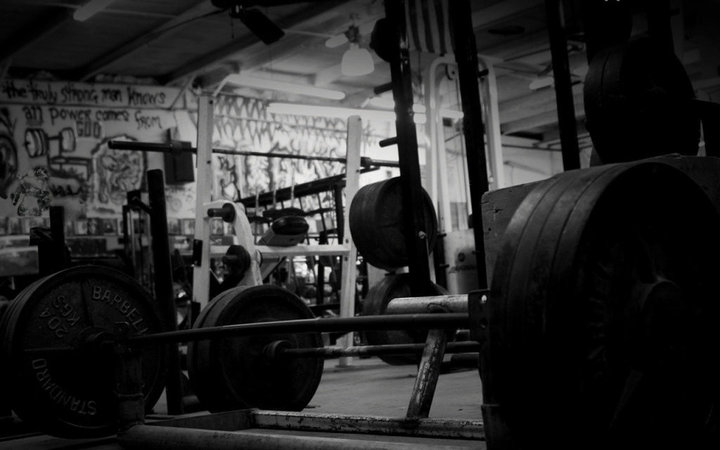
Try to ignore the name for now; instead, consider the fact that not only has DC become an Internet bodybuilding board phenomenon, but DC disciple and pro bodybuilder Dave Henry has acquired 30 lean pounds in less than three years. That’s a lot of’ Crapp. We interviewed DC mastermind Dante Trudel to learn about Doggcrapp’s rapid growth and why its adherents grow so rapidly. Trudel, 38, grew up in Massachusetts and currently lives in Southern California with his wife, Dianne. He co-owns the Internet supplement company Trueprotein.com. At 6’1″, he now weighs a muscular 280, but when Trudel began bodybuilding at age 20, as he jokes, he was a wispy 137 “after a good meal and with four rolls of quarters in my pocket.”
After developing his low-volume rest-pause training style and experiencing his greatest growth, Trudel tutored his friends, who saw similar rapid results. From 1993 to 1995, he published a cutting-edge bodybuilding newsletter called Hardcore Muscle.
However, it wasn’t until Trudel posted his theories on an Internet discussion board six years ago that his ideas began to spread. Unfortunately, he used the screen name “Doggcrapp” for what he thought would be his only post. Much to his surprise, he was deluged with questions, his original post grew to 118 pages and his writings were copied and pasted all over the Internet.
“Sad to say, I’m stuck with the moniker ‘Doggcrapp,'” Trudel laments with a laugh. “If I could do it all over again, trust me, I would’ve gone with a much cooler screen name.”
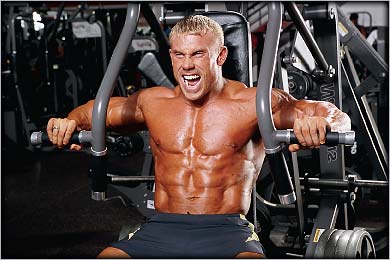
What was your early training like?
I did the “good ol’ boys” programs I saw in the magazines, jumping back and forth according to the latest article. It took me two years of six meals a day and training hard just to look normal at 190. It kind of sucked that I had to gain 50 pounds to look normal, but I had a never-say-die attitude. I went three-and-a-half years barely missing a meal, and if I did miss one, I’d get up at 2 AM and cook it. I really believe that bullheaded consistency in eating put the 50 pounds on me more than any type of training I did.
How did you first develop DC?
After three-and-a-half years of obsessive-compulsive volume training, I started to read everything I could get my hands on concerning nutrition, supplements and training even abstracts and lab studies. I got to the point where I thought, Jeez, there is no rhyme or reason for what people are doing bodybuildingwise. It seemed to me that everything was done with an “I must do inclines, declines, flat bench, flyes, cable crossovers and pec deck or I won’t grow” mentality. I thought about what makes a muscle grow, what would make it grow faster, and to absolutely stop thinking in this “I want to be big so bad I’ll overthink and overdo everything” concept. Why do people think in terms of “annihilating myself into rigor mortis in today’s workout” instead of progression and recovery over weeks, months and years? I started stringing together workouts with a game plan instead of winging it and hoping I was doing the right thing. I was 23 when I scrapped everything and reverse-engineered it. I broke it down, took out all the things I felt were just fluff, and there for ego and obsessive-compulsive satisfaction, and created a planned “powerbuilding” attack.
How fast did you grow when you first started DC training?
As soon as I got down to the brass tacks of what I felt worked and what didn’t, I started gaining again. I had been stuck at about 204, and then after I got my head out of my ass and attacked this like a chess game, I consistently gained. I’ve been over 300, but currently I’m 280. I told my wife I will slowly take it down to about 260 and stay there. I reached my goals, proving to myself that with my extreme ectomorphic qualities I could attain a certain level through incredibly hard work and consistency. Now, I want to learn to tap dance just kidding.
What are the basic principles of DC?
- Heavy progressive weights
- Lower workout volume but higher workout frequency
- Multirep rest-pause training
- Extreme stretching
- Carb cutoffs later in the day
- Morning cardio
- Higher protein intake
- Blasting and cruising phases
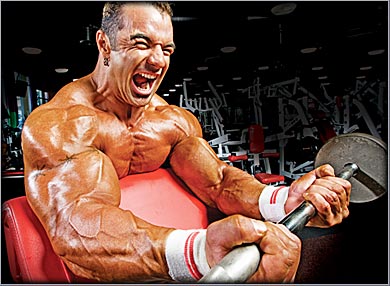
Explain why continuously gaining strength is the essence of DC training.
I believe he who makes the greatest strength gains [in a controlled fashion] makes the greatest muscle gains. Note that I said strength gains. Everybody knows someone naturally strong who can bench 405 yet isn’t that big. Going from a 375 bench to 405 isn’t an incredible strength gain and won’t result in much of a muscle mass gain. If someone goes from 150 to 405 for reps, that incredible strength gain will equate to an incredible muscle mass gain. Ninety-nine percent of bodybuilders are brainwashed that they must go for a blood pump, and those same 99% stay the same year after year. It’s because they have no plan. They go in, get a pump and leave. They give the body no reason to change. A power-bodybuilding game plan stresses continually getting stronger on key movements, and the body protects itself by getting muscularly larger. If you never get anywhere close to your ultimate strength levels, you will never get close to your utmost level of potential size.
How does the three-exercise rotation work?
Pick the three best exercises per bodypart you can rest-pause generally those in which you can safely make maximum strength increases.

For example, close-grip bench presses are better for triceps than kickbacks because you should be able to make more incremental improvements over a longer period. The three exercises will be rotated, using only one of them each time you train that bodypart. If someone only does one exercise over and over, he plateaus on it very quickly. I’ve experimented with this multiple ways, and the three-exercise rotation can keep you from plateauing for a long time.
How important is a journal?
It’s crucial. You must always write down your weights used and reps done, excluding warm-ups, in a logbook. Every time you go to the gym, you have to continually beat your previous weight, reps or both even if it’s just by five pounds or one rep. If you don’t beat it, you lose that exercise from your three-exercise rotation. This adds grave seriousness to a workout. I have exercises I love to do, and knowing I’ll lose them if I don’t beat the previous stats sucks!
If you get to a strength sticking point, you must turn to a different exercise for that bodypart and get brutally strong on that new one. Looking at that piece of paper and knowing what you have to do to beat your best will bring out the best in you.
What training split do you recommend?
My usual recommendation is workout A chest, shoulders, triceps, back width and back thickness and workout B biceps, forearms, calves, hams and quads. I recommend this bodypart order because it puts the hardest bodyparts you have to train back and quads last in your workouts. This is contrary to conventional wisdom, but after doing deadlifts or a “widowmaker” for quads, you’re not going to have the same energy for training anything else. The two-workout rotation is done three times over two weeks on a Monday (A), Wednesday (B), Friday (A), Monday (B), Wednesday (A), Friday (B) schedule. This creates more growth phases. The guy next to you is training chest on Monday and then waiting a week before training chest again two growth phases over 14 days. You, on the other hand, train chest three times in 14 days. He trains chest 52 times a year and grows 52 times, while you train chest 78 times a year and grow 78 times.
You’re doing only one exercise, out of your three rotated exercises, per bodypart each workout while Joe Gymguy over there is doing incline barbell presses, flat dumbbell presses and Hammer Strength decline presses in his chest workout today. You’re doing the same exercises he’s doing over two weeks, but you’re growing at a much faster rate.
For DC, does it matter if someone is a beginner or advanced?
DC isn’t for anyone who hasn’t been lifting hardcore for at least three years. You have to know your body well and your way around a gym before shifting to something this intense.
Why do you stress low workout volume?
On this schedule, you cannot do 12 to 16 sets per bodypart. Lower volume is the only way you can recover to quickly train that bodypart again. Besides, once a growth response is met during a workout, anything you do past that point is pretty much delving into your recovery and catabolizing muscle mass, so I don’t want to take one step forward and half a step back. There are many ways to build muscle. In simple terms, I’m using extreme high-intensity [rest-pause] techniques, which I believe increase a person’s strength as quickly as possible. Along with that is lower volume, for quicker recovery and as many growth phases as possible in a year’s time.
Explain how a DC rest-pause set is performed.
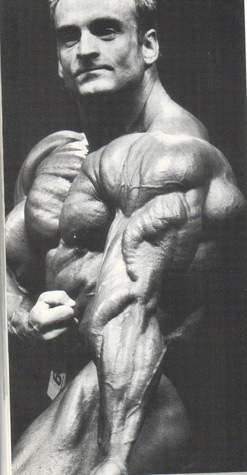 Most of the sets are in the 11- to 15-rep range, although sometimes it’s higher or lower, depending on the bodypart, exercise, safety and health of joints. Every rest-pause set is done with three failure points. A hypothetical incline bench 11- to 15-rep set would start with eight reps to failure, rack the weight, take 15 deep breaths, unrack, two to four reps to failure, rack the weight, 15 deep breaths, unrack, and a final one or two reps to failure.
Most of the sets are in the 11- to 15-rep range, although sometimes it’s higher or lower, depending on the bodypart, exercise, safety and health of joints. Every rest-pause set is done with three failure points. A hypothetical incline bench 11- to 15-rep set would start with eight reps to failure, rack the weight, take 15 deep breaths, unrack, two to four reps to failure, rack the weight, 15 deep breaths, unrack, and a final one or two reps to failure.
Should every bodypart be rest-paused?
Most quad exercises and back-thickness exercises are not rest-paused due to safety reasons. These usually involve incredibly large poundages and, as you grow fatigued during a rest-pause set, it’s easy to lose form. I don’t want someone T-bar rowing 250 and pulling from a bent rest-pause dead stop and getting a serious injury. For quads, I usually recommend a brutally heavy set of four to eight reps followed, after a rest, by a 20-rep set with less weight, but still heavy. I call that 20-rep set a “widowmaker.” Once you do it, you’ll have no question why.
For back thickness, I recommend a brutally heavy set of six to eight reps followed, after a rest, by a slightly lighter set of 10 to 12, going to failure both times.
How many warm-up sets?
Whether it’s one warm-up or five, take as many as you need to get ready for your all-out working sets. This all depends on the person and how advanced he is. For example, if someone was going to rest-pause 405 for incline presses, then his warm-ups might go something like this: 135 for 12 to 20 reps, 225 for 10 to 12,275 for 6 to 8,335 for 4 to 6, then 405 for an all-out rest-pause set of 11 to 15 reps. A bodybuilder using a lot less weight may need only two warm-ups before his rest-pause set.
What is extreme stretching, and what are you trying to accomplish with it?
Extreme stretching can have myriad benefits if done correctly: recovery, fascia size and potential hyperplasia, which is still only theory. It can change your physique in pretty dramatic ways [especially your chest, triceps and quads]. It should be done only after the bodypart has been worked. I recommend extreme stretching for every bodypart except calves, and that’s only because the way I have people train calves already has an extreme stretch built into it. Basically, you want to get into a deep stretch and hold it for 60 to 90 seconds. These are very painful. I’ll walk you through a quad stretch. You just got done quad training, so take an overhand grip on a barbell fastened in a power rack about hip high and simultaneously sink all the way down. Push your knees forward and under the barbell until you’re on your toes basically a sissy squat. Now straighten your arms and lean as far back as you can, and hold that stretch for 60 to 90 seconds. It’s going to be excruciating for most people.
Do this one faithfully, and in four weeks your quads will look a lot different than they used to.
How important are static contractions?
I like to get people confident in the ability to handle big poundages, instilling the mentality that they are in control of the weights and not vice versa. For this reason and for “time under tension” purposes, some trainers should do a static contraction or static reps short two-inch range of motion reps at the end of their rest-pause set.
How should trainers use cardio?
In the offseason, if you train three days a week, then do cardio on the four off days. If more people took that approach, you would have fewer offseason bodybuilders looking like sumo wrestlers. Cardio is a very individualistic thing, so it’s hard for me to say “do this” in an article without knowing a great deal about who’s reading it. I’ve found that if people who have a difficult time gaining weight do cardio walking on a treadmill or around the neighborhood first thing in the morning, appetite and muscular weight gains become nonissues. I’d have them get up, take in either branched-chain amino acids or a scoop of protein powder, do their cardio and then eat the day’s first meal. The old wives tale that you can’t gain muscle mass if you do cardio is the biggest bunch of crap.
If done right, cardio is a huge weapon in a bodybuilder’s arsenal.

What are the basics of the DC nutritional philosophy?
- Use a higher protein intake 1.5 grams to upward of 2 grams per pound of bodyweight.
- Drink at least a gallon of water daily in direct relation to your protein times bodyweight ratio. For example, if you take in 1.5 grams of protein per pound of bodyweight, drink at least one-and-a-half gallons of water daily.
- Except for postworkout carbs, most people should take in no carbohydrates after 6 PM, primarily so morning cardio is done with lower glycogen levels.
- Eat either protein and carbs or protein and fats, but don’t mix up those components greatly. You don’t have to be absolutely meticulous with this, but it’s a generalized way to keep most people from creating insulin spikes and driving fats toward adipose tissue.
- Meals that are protein and carbs are usually eaten in this sequence: protein first, fiber and veggies second, carbs last. This is simply because about half the time you’re so full after the steak, salad and broccoli that you don’t eat all the carbs, and for bodyfat control, that’s a good thing.
- There are some individuals who should eat mainly protein and fats because they are so carb-sensitive, and other people who should take in carbs only pre- and postworkout. It’s one of those things where I have to ask a lot of questions of the person, and I come up with a game plan.
Basically, I try to trick the human body into getting larger by becoming a muscle-building fat-burning machine. In the simplest of terms, if you’re 180 and want to weigh 200, you’d better eat like a 220-pounder to get there. I say eat and train like a 300-pounder, cardio like a guy who is 8% [bodyfat] and shore up all excesses with carb cutoffs, food combinations and key supplements green tea, etc.
What are blasting and cruising phases?
I recommend people train all out for six to eight weeks [blasting] and then take a 10- to 14-day period [cruising] in which they remove one meal per day and do only maintenance training. During the cruise, only go to the gym two or three times, go through the motions with straight sets and try out some new exercises you might switch to if you’re close to strength plateaus on any current ones. Guys come off that 10- to 14-day cruise like rabid dogs chomping at the bit to get blasting again. Blasting and cruising must be done. You cannot train all-out all the time without overtraining. Blast and cruise back and forth all year long.
Let me play devil’s advocate.
Our muscles can’t see the weight or count the reps; they only react to stress. As long as I keep stressing them enough, why do I need to get another rep or use another five pounds? Why can’t I stress my muscles as much as a DC adherent with, say, supersets or drop sets or new exercises?
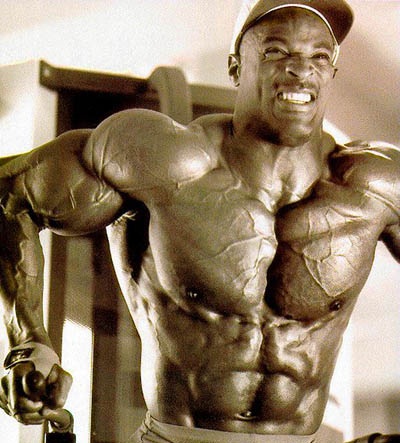
I think I can answer that best by asking the readers a question. Would Ronnie Coleman, or any top pro, be the size he is today if he stayed lifting the same light weights he started with when he was a beginner?
What its all about…
Bodybuilding is all about creating continual adaptation. The number of exercises you can do per bodypart is finite. How many good quad-building exercises are there? Six, maybe? The number of sets volume you can do is finite or infinite if you want to spend the next 3,200 hours straight in the gym. As for supersets or drop sets or whatever, after you do them this time, what are you going to do next time to make sure you went above and beyond the supersets and drop sets you did this time? Anyone reading this can giant set squats, leg presses, hack squats and lunges, and they will be blown out and sore as hell for the next few days. They could do that exact same workout with the same exercises and weights every leg workout for the next year and they’d be blown out and sore for days each time.
Are they really going to gain any leg mass after the second or third time? No, because nothing has changed in the parameters to cause an increase in muscle size.
What is pretty much infinite in training? Poundage.
You take a key exercise up to an extreme strength plateau, and at that very point, switch to a new key exercise and get brutally strong on the new one; you do that continually. That repetitive progression that you’re held accountable for in your logbook is the key game plan to get to point B where you want to be from point A where you are at the absolutely quickest rate possible.
We’ve covered a lot of ground. What one thing would you most want people to take away from this article?
A lot of what bodybuilding is about for many people is obsession-compulsion instead of deductive reasoning. I would like people to start thinking of how to get to point B from point A in the shortest route possible. I am not claiming to have built a better mousetrap, but I think I’m showing how to catch the mouse quicker.
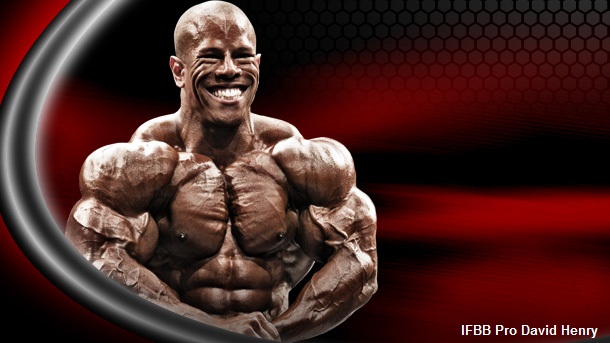
“Dante’s teachings have taken me to the next level. Most people hit plateaus, but this style of training is all about progress. If there’s a plateau, you move around it and keep going. It’s all about getting progressively stronger.” — David Henry
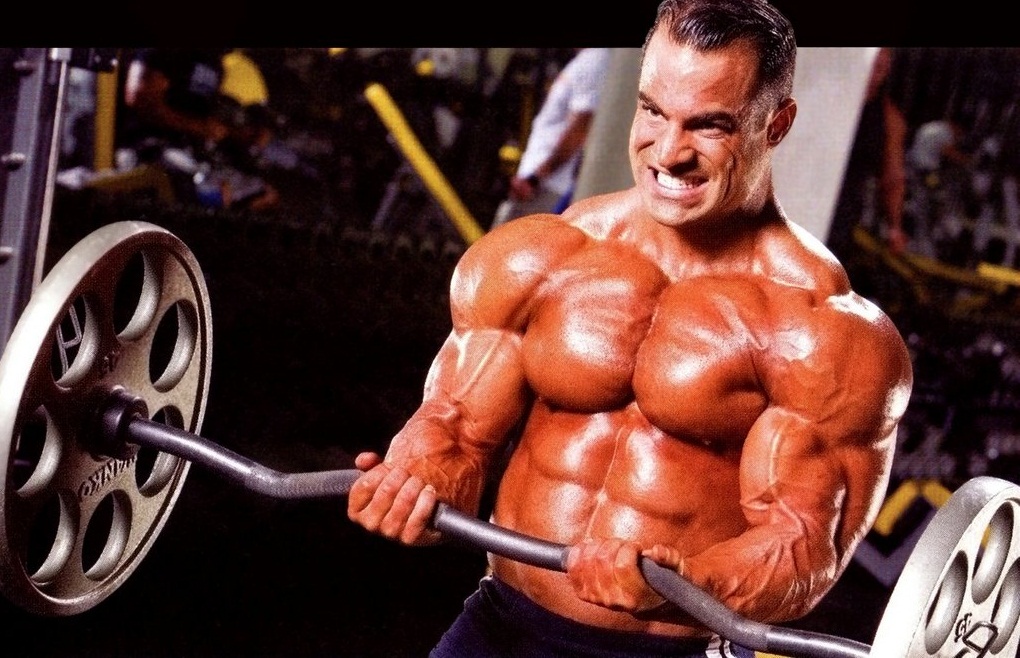
“I’ve been doing Doggcrapp since shortly after the 2006 Ironman. I’m not sure I’m going to stick with it precisely. I’m still into more of Dorian Yates’ style, but there are things I’ll take from Doggcrapp. I really like the rest-pause sets, and the ‘widowmakers’ for legs have been brutal. I do think the Doggcrapp philosophy that gaining strength is the key to gaining mass is 100% correct.” — Mark Dugdale
Example Of A Doggcrapp Cycle
- The exercise numbers (in orange) correspond to individual workouts. In our example, only the five number-one exercises are done in the first workout, only the five number-two exercises are done in the second workout, etc.
- Each working set is preceded by one to five warm-up sets.
- The additional set of 10-12 reps for rack and regular deadlifts, as well as the 20-rep additional “widowmakers” for quads, is performed after a rest and with lighter (but still heavy) weights.
- Abs can be trained on any day, typically with one warm-up set and one working set to failure of both a crunching movement and a leg-raise movement. Working sets can be either rest-pause sets for 20-30 reps or straight sets for 15-20 reps.
Exercise & Reps Per Working Set
“A” Workouts
Chest
- 1 Incline Smith machine presses 11-15 rest-pause
- 3 Flat-bench barbell presses 11-15 rest-pause
- 5 Hammer Strength chest presses 11-15 rest-pause
Shoulders
- 1 Military presses 11-20 rest-pause
- 3 Medium-grip upright rows 11-15 rest-pause
- 5 Smith machine shoulder presses 11-20 rest-pause
Triceps
- 1 Close-grip bench presses 11-20 rest-pause
- 3 Lying triceps extensions 15-30 rest-pause
- 5 Machine dips 11-20 rest-pause
Back (Width)
- 1 Hammer Strength 11-15 rest-pause underhand pulldowns
- 3 Front wide-grip pulldowns 11-15 rest-pause
- 5 Close-grip pulldowns 11-15 rest-pause
Back (Thickness)
- 1 Deadlifts 6-9 9-12
- 3 Rack deadlifts 6-9 9-12
- 5 T-bar rows 10-12
“B” Workouts
Biceps
- 2 Barbell drag curls 11-20 rest-pause
- 4 Seated dumbbell curls 11-20 rest-pause
- 6 Machine curls 11-20 rest-pause
Forearms
- 2 Hammer curls 10-20
- 4 Barbell wrist curls 10-20
- 6 Cable reverse curls 10-20
Calves
- 2 Leg-press toe presses 10-12
- 4 Machine donkey calf raises 10-12
- 6 Seated calf raises 10-12
Hamstrings
- 2 Lying leg curls 15-30 rest-pause
4 Sumo leg presses (feet high and wide, press with heels) 15-25 - 6 Seated leg curls 15-30 rest-pause
Quadriceps
- 2 Squats 4-8 20
- 4 Hack squats 4-8 20
- 6 Leg presses 4-8 20
All calf exercises are done with an enhanced negative portion of the rep. Each rep consists of five seconds of lowering down to a full stretch, a 10- to 15-second hold in the stretched position, then rising onto the toes.
Workout Schedule

Notes:
The numbers 1 through 6 correspond to the exercise numbers in the Doggcrapp cycle chart. Follow a pattern of A and B workouts for the bodypart split. Beginning with week 3, this pattern repeats, starting with the #1 exercises.
References:
http://www.muscleandfitness.com/
http://www.flexonline.com/
COPYRIGHT 2010 Weider Publications
COPYRIGHT 2010 Gale Group










